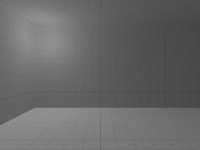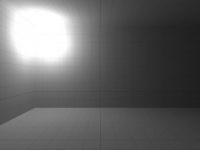Constant-Linear-Quadratic Falloff
This page either contains information that is only partially or incorrectly translated, or there isn't a translation yet.
If this page cannot be translated for some reason, or is left untranslated for an extended period of time after this notice is posted, the page should be requested to be deleted.
Also, please make sure the article complies with the alternate languages guide.
Introduction
Pendant que la lumière voyage de sa source, elle baisse en intensité, ce qui limite la zone que la source pour illuminer. Cette baisse se nomme "atténuation de lumière" ou fall-off.
L'atténuation d'une lumière normale et non-modifiée et mise pour être 100% quadratique. Pendant que cela est une simulation réelle de l'atténuation (selon inverse-square law), cette valeur est trop rapide pour les environnements virtuels, ce qui donne des formes brillantes surnaturelles (comme le plafond).
The Constant-Linear-Quadratic system is an old system for adjusting how a light attenuates (or "falls off"). It has since been superseded by the two "percent falloff distance" keyvalues, which some may find easier to understand and handle.
The ratio between the three keyvalues Constant (_constant_attn), Linear (_linear_attn) and Quadratic (_quadratic_attn) will determine the way in which the light attenuates. (The three values has gotten their names from the mathematical function used to describe the decline of its intensity.)
Constant Attenuation
The picture on the right shows a lightsource displaying the simplest of attenuations: Constant attenuation. The keyvalues Constant, Linear and Quadratic have here been set to "1", "0" and "0" respectively, creating a Constant-Linear-Quadratic ratio of 1:0:0, meaning that the attenuation is 100% Constant, 0% Linear, and 0% Quadratic.
The 100% constant attenuation will result in a light that has no attenuation at all. The intensity, represented by the brigtness setting of the light entity, will be totally unaffected by distance, continuing until it hits a surface, theoretically capable of illuminating an infinite area. This type of light can be seen from the sky (sunlight, monlight and starlight), and other large and distant light sources. It can also be used for setting local ambient lighting (by letting it illuminate the shadows of the room) or mood lighting.
As a 100% constant lightsource is an extreme type of light, constant light is mostly used in combination with the other two types of attenuations, to "soften" or limit them.
Linear Attenuation
This is the same light entity, but at a 0:1:0 ratio, making its lighting 100% linear instead.
Mathematically, the decline of this type of light is linear, inversely proportial to the distance from the light source (I = 1/d where I is intensity and d is distance). This means that the light intensity (set by its brightness) will diminish (at a fixed rate) as it travels from its source. To compensate for this decline, Valve has boosted the intensity of the lightsource to 100 times its brightness.
In the real world a 100% linear lightsource would be practically impossible, as it would represent a real world soft light of infinite size, but in the virtual world, a 0:1:0 lightsource is believable for most entity based lightsources.
Quadratic Attenuation
This is a normal, unmodified light source, preset to 0:0:1, making it 100% Quadratic.
Mathematically, the attenuation of a 100% quadratic light is exponential (quadratic), expressed as "I = 1/d^2", meaning that the further the light travels from its source, the more it will be diminished. This creates a very sharp drop in light. To compensate for the fast decline of quadratic lights, Valve has boosted the intensity of them to be 100^2 (10 000) times more intense than the actual intensity.
An unmodified (100% quadratic) lightsource represents a pure "point light source" in the real world. In the virtual world, this effect looks like a lightsource shining through murky water, looking far from typical real world lightsource behavior.
When used in moderation, quadratic attenuation can be used not only for small lightsources, but also to reflect light travelling through something more dispersing than air, like air humidity (like fog) or water.
Mixing Attenuation
When blending between these three types of attenuation, you set the proportions of each attenuation type against the other two types. To avoid confusion, keep in mind that you can set the scale of these proportions as you wish: A proportion of 3:6:1 gives the exact same result as 6:12:2, or 30:60:10, which can easily be translated to 30%, 60% and 10%.


